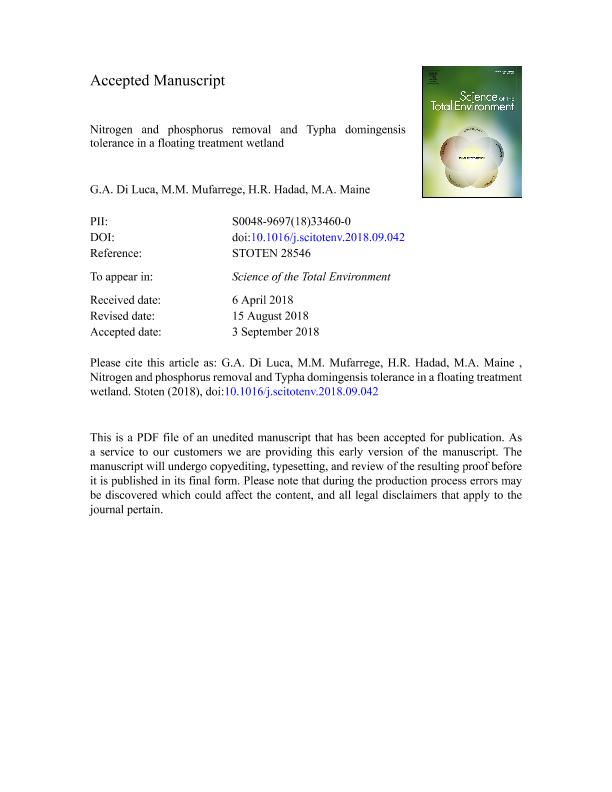Artículo
Nitrogen and phosphorus removal and Typha domingensis tolerance in a floating treatment wetland
Di Luca, Gisela Alfonsina ; Mufarrege, María de Las Mercedes
; Mufarrege, María de Las Mercedes ; Hadad, Hernán Ricardo
; Hadad, Hernán Ricardo ; Maine, Maria Alejandra
; Maine, Maria Alejandra
 ; Mufarrege, María de Las Mercedes
; Mufarrege, María de Las Mercedes ; Hadad, Hernán Ricardo
; Hadad, Hernán Ricardo ; Maine, Maria Alejandra
; Maine, Maria Alejandra
Fecha de publicación:
02/2019
Editorial:
Elsevier
Revista:
Science of the Total Environment
ISSN:
0048-9697
Idioma:
Inglés
Tipo de recurso:
Artículo publicado
Clasificación temática:
Resumen
The aim of this work was to study the efficiency of microcosms-scale floating treatment wetlands (FTWs) in the N and P removal from a synthetic runoff effluent and to evaluate the effluent tolerance of Typha domingensis. Each FTW consisted of a raft constructed with a plastic net where T. domingensis plants were installed. In order to evaluate the plant role, reactors with FTWs and without FTWs (controls) were used. P and N additions were carried out as follows: 5 mg L−1 P (P5 and P5-control); 10 mg L−1 N (N10 and N10-control); 5 mg L−1 P + 10 mg L−1 N (P5N10 and P5N10-control). Also, a biological control (B-control) without contaminant addition was used. The removal of soluble reactive phosphorus and total phosphorus were significantly higher in the FTWs than in the controls. Ammonium and nitrate concentrations were not significantly different between FTWs and controls at the end of the experiment. However, nitrate concentrations showed significant differences between FTWs and controls during the experiment. N and P were mainly accumulated in plant tissues and not in the sediment. Plants tolerated the effluent conditions and showed a positive growth rate. The use of FTWs is a promising strategy for the sustainable treatment of water bodies affected by runoff waters.
Palabras clave:
EFFICIENCY
,
EMERGENT MACROPHYTES
,
FLOATING WETLANDS
,
RUNOFF EFFLUENT
Archivos asociados
Licencia
Identificadores
Colecciones
Articulos(IQAL)
Articulos de INSTITUTO DE QUIMICA APLICADA DEL LITORAL
Articulos de INSTITUTO DE QUIMICA APLICADA DEL LITORAL
Citación
Di Luca, Gisela Alfonsina; Mufarrege, María de Las Mercedes; Hadad, Hernán Ricardo; Maine, Maria Alejandra; Nitrogen and phosphorus removal and Typha domingensis tolerance in a floating treatment wetland; Elsevier; Science of the Total Environment; 650; Parte 1; 2-2019; 233-240
Compartir
Altmétricas



